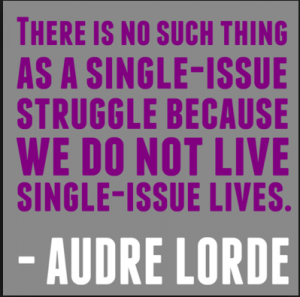Studying intersectionality quantitatively
 I came across a blog recently that details the complexity involved in studying intersectionality from a quantitative perspective. Anyone who has encountered such questions in their own work can identify with the frustrating nature of accounting for an anti-categorical approach that is already quite complicated in theory. And yes, I said anti-categorical. As a quantitative researcher, “anti-categorical” is paradoxical to what we do. We live by quantifying things!
I came across a blog recently that details the complexity involved in studying intersectionality from a quantitative perspective. Anyone who has encountered such questions in their own work can identify with the frustrating nature of accounting for an anti-categorical approach that is already quite complicated in theory. And yes, I said anti-categorical. As a quantitative researcher, “anti-categorical” is paradoxical to what we do. We live by quantifying things!
So what is one to do if so quantitatively-inclined? How can we, as scholars, accurately represent intertwined identities in research? The very notion that social categories (e.g., race, SES, gender, sexual orientation) are not independent and unidimensional but rather multiple and mutually constitutive, is both reasonable and rational, but very difficult to measure. Over the years, I have had many conversations with people (just like me) who are overwhelmed at the idea of accounting for intersectionality from a quantitative perspective. “Oh the categories!” Or perhaps, “What size N would we need to have for something like that?!” While easily mind boggling, these questions also reflect a fundamental misunderstanding of the intersectional perspective.
Let’s review. First, as a health researcher it is important to acknowledge that the intersectionality framework did not originate from public health research, nor was it designed to specifically predict health outcomes or processes. However, its utility lies in the potential to examine and explore health disparities. The standard method of studying disparities is a comparative approach (e.g., Black/White or male/female differences). While useful to some extent, a comparative approach misses what I consider to be the most critically important questions. WHY are there mean differences between these two groups on say, chronic disease? To what extent is within-group variation shared between both groups? In other words, comparing health outcomes between two groups (A and B) can only give you half (at best) of the big picture. If we are concerned with preventative health strategies and fundamental causes, then we must also be concerned about questions that address the origins of such disparities.
 Therefore, a significant challenge for intersectionality researchers is to adapt a perspective originally designed as an analytical theory into a model that might be useful to empirically examine say, social inequalities in health. Tall order, huh? Lisa Bowleg eloquently addresses this issue in a 2012 American Journal of Public Health publication:
Therefore, a significant challenge for intersectionality researchers is to adapt a perspective originally designed as an analytical theory into a model that might be useful to empirically examine say, social inequalities in health. Tall order, huh? Lisa Bowleg eloquently addresses this issue in a 2012 American Journal of Public Health publication:
“Thus, for public health and other social science researchers, the absence of theoretically validated constructs that can be empirically tested poses not only a major challenge but also tremendous opportunities for advancing the study of intersectionality from a public health perspective.”
Nice way to take lemons and make lemonade. Did you catch that? As public health researchers, there are great opportunities to uncovering ways to study intersectionality! So, back to the original question of how to actually do that in practice. There are several possibilities. Bowleg suggests more use of qualitative or mixed-methods research in public health research (I’m a fan of this idea). Given that I research intersections, I have devoted considerable thought to the topic and one approach that has been very rewarding and fruitful for me is within-group analysis. I’m sure you might be thinking, “But how can we possibly find out anything interesting about ____ people if we don’t compare them to ____ people??!” Ah yes. I’ve encountered different variations of this question over the years, and to that I reply, “It’s simple. No one group is monolithic.”
In essence, we are all complex and if I am concerned with Black women’s health, for example, I cannot fully understand Black women if I am only comparing health outcomes between Black and White women. Within-group research (studying only one group) allows us to understand the wonderful complexity that exists within a group of people who share one social identity. For example, Black women are extremely diverse. However, that diversity can easily get lost if you don’t take into account education, class background, geographic location, and other features of the social context that shape the human experience. Furthermore, there is a tremendous amount to be learned from understanding variability between risk and resiliency. Not all Black women develop diabetes, cardiovascular disease and die young, but some do. Why? And why does upward mobility not yield the same beneficial effects in terms of infant mortality for educated Black women, as for White women? These important questions require a thoughtful and deliberate approach to not only examining disparities, but actually doing something to help prevent them.
Natalie Sabik and I will be presenting our work on intersectionality and physical functioning among older African American women at the Intersections of Race, Culture, Health and Mental Health Conference at Boston College, October 18-19th.
Note: Just ordered Evelyn Simien’s Black Feminist Voices in Politics – an intersectional analysis. Can’t wait to read!